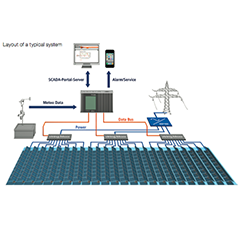We’re delighted to be joined by Gantner Instruments’ Annette Christine Kehrer, who writes about her company’s creative systems and how they can be applied to real-world PV scenarios.
In large solar power plants, monitoring equipment is becoming constantly more complex and important: system operators want to find faults in modules, strings or groups quickly and precisely to ensure that their equipment can continue to operate profitably – as planned. During operation the total of all power generated should be at its maximum and long equipment service life guaranteed by optimal monitoring.
For such demanding measurements, Gantner Instruments offers intelligent solutions from the string level to the data and SCADA levels.
String Level
String monitoring with string.bloxx modules allows precise control on the DC side of photovoltaic systems independent of the inverter, ensuring early recognition and correction of faults such as:
• Contamination by pollen, dust or soot
• Shadows in partial areas
• Theft or vandalism
• Effects of weather (hail, snow loads)
• Installation and production faults
Moreover, the string.bloxx modules are distinguished by the following outstanding properties:
string.bloxx for precise measurement
The shunt principle used in the string.bloxx modules offers users many advantages for measuring current on PV equipment. A comparison verifies the significantly higher temperature stability in comparison to units operating with hall sensors.
The new string.bloxx product series uses a shunt measuring principle to achieve a high accuracy of 0.25 % as well as good stability of 0.01 %/K. This high accuracy is important to allow precision measurement even with minimum solar radiation. Gantner Instruments therefore offers a great advantage in comparison to conventional measurement with hall sensors, which supply considerably less precise and, above all, temperature-dependent results at this point.
In a climate chamber a string.bloxx with internal shunt and a unit with hall sensor were both exposed to a temperature of 25°C to 70°C corresponding to the blue (lower) curve. A precision reference current of 10 A was applied to the measuring inputs of both units being compared.
The brown (upper) curve shows a deviation of 550 mA at a zero error of 400 mA over the temperature change. Based on a measuring range of 20 A, this corresponds to a deviation of nearly 3 % at a zero error of 2 %.
Easily recognisable is the good stability of the string.bloxx with a deviation of 150 mA, corresponding to approx. 0.01 %/K.






























